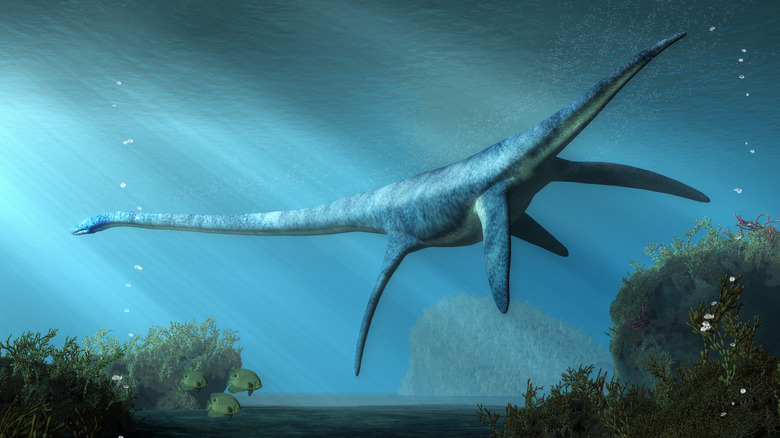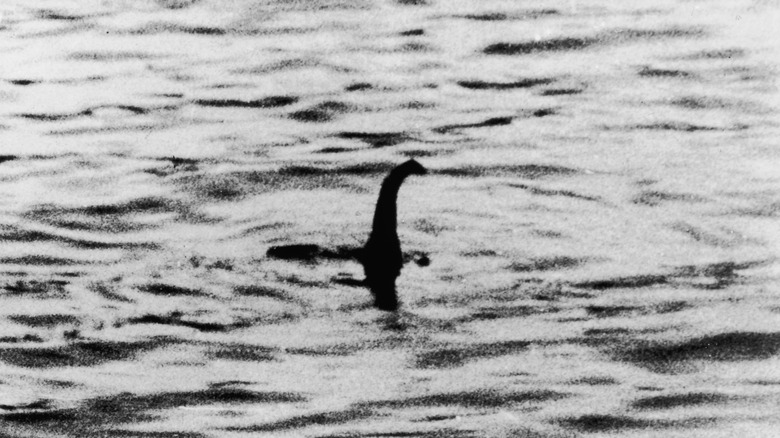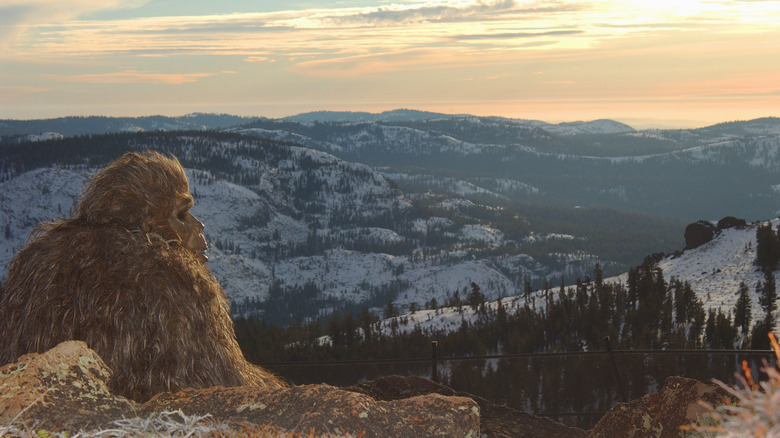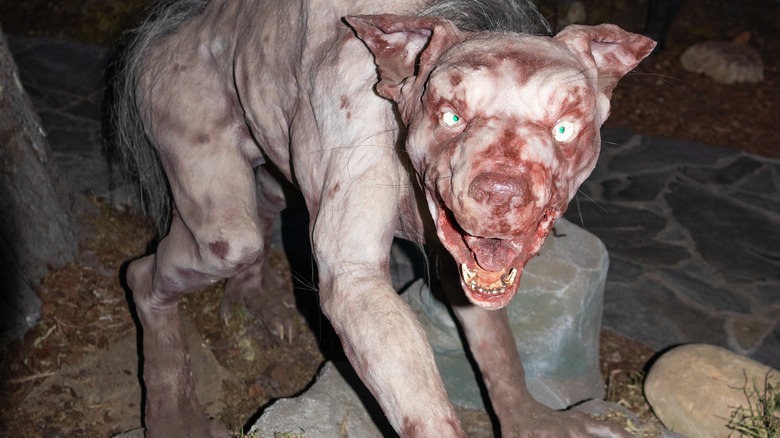The Weird Science Behind The Hunt For Cryptids
In our world of ever-developing science and technology there are few areas of study that are free from advancements. As it turns out, cryptozoology — the study of purported, but unconfirmed animal species like the Loch Ness Monster – is also getting a tech makeover. In the history of Bigfoot hunts and attempts to plumb the depths of Loch Ness in Scotland, night cameras, underwater photography, and even sonar have been employed (per Vice). Whether you believe, or simply want to believe, there are cryptids crawling and swimming among us, there's no denying the need for good science to either confirm or debunk them (per Smithsonian).
One of the early examples of the scientific cryptid search started when a video was captured of an alleged bipedal ape wandering around Northern California. It's remembered as the Patterson-Gimlin footage, named after the men who shot the video while out trekking in the wilderness. The blurry footage divided skeptics and believers, as did later photos of footprints and shadowy, ape-like creatures (via Outside). Similarly, the aquatic cryptid of Scotland's Loch Ness began with a low-fi image that was later deemed a hoax (via Britannica). But today, the search for these beasts and many others continues, igniting the enthusiasm of believers in both science and the paranormal.
The belief in cryptids
The creatures we know well in popular media are sometimes explained using research from paleontology. Some claim the Loch Ness Monster is actually a plesiosaur — a long-necked creature who swam the Jurassic seas. Bigfoot has also been linked to an actual species known as Gigantopithecus, an ancestor of modern orangutans and the largest ape that ever existed, per Live Science. Although cryptozoologists ground some of their ideas in scientific research, critics claim that they're relying on questionable evidence of blurred photos and videos, plus dubious eyewitness testimony (via Scientific American).
While cryptozoology, taking its name from the field of zoology and the Greek word "crypto," meaning "hidden or concealed," sounds like a science, it is not accepted by the scientific community. While skeptics want bodies to examine or signs of a breeding population before digging deeper, cryptozoologists put enough weight on less concrete clues. Donald Prothero, co-author of the 2012 book "Abominable Science! Origins of the Yeti, Nessie, and Other Famous Cryptids," told National Geographic, "You can talk about their population density, the size of range they should have based on their estimated body size. All of that tends to weigh against them being real." Still, believers hold on to the notion that witnesses know what they've seen, and many are determined to prove it.
The scientific search for the Loch Ness monster
The Loch Ness Monster, also called Nessie for short, is part of a legend that goes back to ancient Scotland. In medieval times, the Pict people created carvings of a monster with flippers that inhabited the lake. The legend intensified in 1933 when a new road adjacent to Loch Ness offered a clear view of the lake. Travelers and locals could now look out for the beast of myth, and in April of that year, a couple claimed a dinosaur-like creature wandered past them and slid into the lake. The story hit the newspapers and the following year, a physician named Robert Kenneth Wilson produced the famous, hazy photo that set the legend ablaze, per Britannica.
Although the object in the photo was later discovered to be plastic and wood atop a toy submarine (via Britannica), the quest for the ancient beast continues. According to Vice, Google decided to offer a 360-degree street view of Loch Ness so spectators could hunt for Nessie from home. This brought a 21st century edge to the search, which had been undertaken by sonar scans in the past. Between 1960-1987 Tim Dinsdale, a famed Nessie hunter, attempted to catch the prehistoric critter on camera, but that proved as luckless as sonar. According to Donald Prothero, such results aren't surprising, since Loch Ness was under a mile of ice until 20,000 years ago, making it challenging for a plesiosaur to sail in to begin with (via National Geographic).
Bigfoot strolls on the scene
In 1967, footage to rival the 1934 image of Nessie came to the forefront. Cowboys Bob Gimlin and Roger Patterson rode out to Bluff Creek, California in late October and saw in the distance a large, upright ape striding along the terrain until it disappeared in the woods. The shaky footage was taken on a 16mm camera and captured in muted colors the alleged cryptid. Although its authenticity was questioned, it spurred investigations that involved trail cameras, the collection and analysis of hair samples, and casts and photos of footprints said to belong to Bigfoot. What also lent credence to the idea was that Native American legends had told of the wild man called "Sasquatch" in many oral traditions (per Outside).
Despite little evidence turning up over the years, in 2012, an Idaho State University professor developed the "Falcon Project" which involved the use of a remote-controlled blimp to capture footage of the large ape. The $300,000 program follows in the footsteps of other aerial efforts to track down Bigfoot, with Animal Planet bringing a UAV plane (a drone) into the investigation (via Smithsonian). Even with the help of DNA analysis, night vision goggles, recorders, and thermal imagers (not to mention the drones), no solid evidence has turned up yet to prove Bigfoot roams our forests, as per Outside.
Chupacabra takes to the field
According to researcher Ben Radford, the Latin American beast known as El Chupacabra is a fairly young addition to the cryptid family. Dating back over 20 years, the creature stands out for being the most supernatural in its gifts, as it resembles a vampire more than any known animal. The name is Spanish for "Goat Sucker" because the dry corpses of inexplicably deceased farm animals were attributed to its blood lust. According to a 1995 sighting from a Puerto Rican housewife, El Chupacabra stands on two legs, has large eyes, spindly arms, and an overall extraterrestrial appearance (via ABC). But as it has with the other elusive animals, science comes to assist with the mystery.
As with Bigfoot, wildlife cameras have been set up in farmers' fields, but they never turned up conclusive evidence. Luckily, however, the Chupacabra mystery offered more physical evidence for scientists to work with. The livestock alleged to be drained of blood turned out upon further examination to contain plenty of blood, except at the site of the wounds. The purported bodies of Chupacabras have also been dissected and DNA tested, only to find that most of the Chupacabras were, in fact, coyotes with mange, a condition that causes almost complete hair loss, per Live Science. Although the phenomenon of El Chupacabra has solid scientific explanations, there's a good chance the lore behind the creature isn't ready to retire.
Are these animals myth or science?
At one time, giant squid and even gorillas were animals of legend, not science (via Live Science), but since then, we've expanded to nearly every corner of the planet, thus making it unlikely that animals as enormous as Bigfoot and Nessie could slip by. But there may be more truth to these cryptids than we realize. Recent studies out of Australia have shown that oral traditions can remain faithful to the original tale for many thousands of years (per The Guardian). The indigenous people of Flores, Indonesia tell tales of a wild man called the Ebu Gogo, which resembles an actual hominid who lived on that island in prehistory. It's unknown if the story is pure myth or oral memory, but it's enough to give one pause (via Live Science).
But many cryptozoologists want to know if the species of the past are extant. In 1938, a major discovery was made toward this end when a curator from South Africa discovered a fish called coelacanth, an animal known only from the fossil record and presumed extinct for millions of years. Locals were already familiar with the fish and called it "gombassa" (per Live Science). It's hard to deny that the ecological impact of large-bodied primates and sea creatures would be quite conspicuous, especially in modern times. But even if the famed cryptids don't show up with the newest science, who's to say something of equal grandeur won't be discovered?





